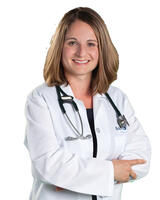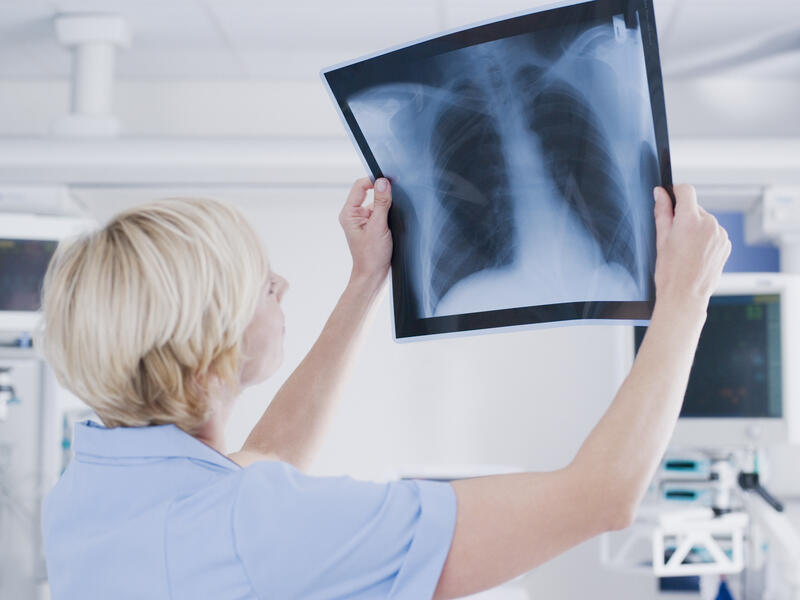Amy Sanford, M.D., is a Sanford Health hematologist/oncologist who provides compassionate care for patients with cancers and blood disorders. She cares for patients at the Sanford Cancer Center in Sioux Falls, South Dakota, and provides outreach services in Vermillion, South Dakota.
She answered a few frequently asked questions about lung cancer and screening.
What are the main causes of lung cancer?
Tobacco use, mostly cigarette smoking, is the highest risk factor for lung cancer within the developed world. In developing nations there is a bigger contribution from air pollution, but the vast majority of lung cancer in developed nations like the United States is tobacco-related.

Does vaping cause lung cancer?
Time will tell — but there is a high likelihood that it will be found to cause lung cancer. To determine if something causes cancer you need lag time in your research. Right now vaping is still too new to state with certainty if it will cause cancer. Twenty years from now we will have more information on whether it causes lung cancer. Some of the aerosols in the vaping agent are known carcinogens. So while we can’t say for certain right now, I would anticipate in the future vaping will be associated with lung cancer.
Does radon cause lung cancer?
We do know that radon exposure can contribute to the risk of developing lung cancer. Radon is a gas that is present naturally in the soil and water and rocks. It is a known carcinogen and a risk factor for lung cancer. Older homes should be tested for radon exposure and if it’s present, there are mitigation systems that can reduce that exposure. Newer homes tend to have those systems in place.
What are the warning signs of lung cancer?
Many lung cancers are asymptomatic until they are very advanced. And so for a lot of people, they don’t know that they have a cancer. Symptoms that we do see can depend on the location of the cancer.
If the cancer is affecting a certain airway, people can experience a cough. Some people cough up blood. If the cancers are advanced and centralized, some people will present with shortness of breath or chest pain. If we get vascular involvement, people can get swelling in their arms or swelling in their face.
How do you get screened for lung cancer?
Lung cancer screening is something that we need to push and promote. Of all of the cancer screens that we do, lung cancer screening has the biggest reduction in mortality, meaning that we detect and save more lives with lung cancer screening than any other cancer screenings. So for people out in the community, it would start by talking to their primary care physician. Our Sanford clinical guidelines recommend screening for people between the ages of 50 and 77 who don’t have symptoms of lung cancer, but are at high risk for the disease because of their smoking history.
People whose smoking history includes 20 “pack years” would qualify for a lung cancer screening CT (computed tomography) scan, which is a low dose CT of their chest. It’s something that people who qualify for should do once a year.
A pack-year is smoking an average of one pack of cigarettes per day for one year. For example, a person could have a 20 pack-year history by smoking one pack a day for 20 years or two packs a day for 10 years.
How does lung cancer usually start?
Lung cancer starts the way all cancers do. A cell has acquired a mutation that makes that cell live forever — it’s an immortal cell. Those mutations can happen in genes that are supposed to stop growth or happen in genes that are supposed to promote growth. So lung cancer starts because of cell mutations. For a lot of people with cigarette-related lung cancer, the cigarettes serve as a carcinogen that promotes that cell mutation.
Does lung cancer spread quickly?
There are two different main categories of lung cancers. One of them does spread much more quickly than the other. With small-cell lung cancer, for example, the cancer can double in size in a matter of four to six weeks. The more common kind of lung cancer, a non-small cell lung cancer, has a slower rate of spread. You could have a lung cancer that is present for a year or more and grow more slowly over that time.
How many different types of lung cancer are there?
There are multiple different kinds of lung cancer, but they are categorized as non-small cell lung cancer or small-cell lung cancer. All lung cancers fall under one of those two umbrellas.
How is lung cancer treated?
Treatment can be very different depending on what kind of lung cancer a person has and what stage they have. For early-stage lung cancers that we detect with lung screening CTs, for example, we can often cure those with surgical resection or radiation if patients aren’t candidates for surgery.
If it is more advanced, we treat people with both chemotherapy and radiation together at the same time. For people who have stage-IV cancers, the primary treatment is systemic therapy – that is, chemotherapy with or without immunotherapy which are medications that go throughout the whole body.
What can you tell people who may be reluctant to pursue a screening because they don’t want to deal with their smoking habits?
The message I want to get out to the community is to get your lung screening CTs. I would love it if everybody quit smoking. But if you are still smoking, don’t let that stand in your way of talking to your primary care doctor about getting your lung cancer screening test. Cancers that are detected with screening CTs are often found at earlier stages. These are cancers we often get the opportunity to cure, as opposed to cancers that we detect when somebody has enough symptoms to present with. By the time people have symptoms of their cancer, we often do not have curative treatment options.
I would love for everybody who is still actively smoking to get their CT scans. I would love to have the opportunity to talk to them for years about quitting smoking while we follow their early stage lung cancer as opposed to meeting them when they have a terminal disease.
Learn more
- Lung cancer: Chances, symptoms and prevention
- Quit smoking or using tobacco: A how-to for your health
- Mother of triplets quits smoking for her babies and herself
…
Posted In Cancer, Cancer Screenings, Cancer Treatments, Sioux Falls, Vermillion
